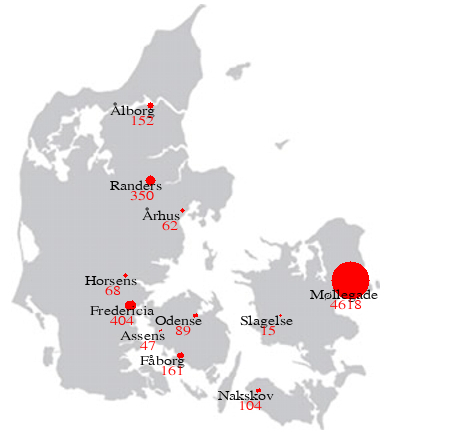Short Introduction to the Database

Fig. 1. The 11 Jewish cemeteries covered by the database. Until 1886 all Jewish
burials in modern Denmark took place on these 11 cemeteries, by far the major part
in Mollegade in Copenhagen. The numbers denote the numbers of known burials on
the cemeteries.
This is a photographic database covering Mosaic funerals in modern Denmark with a special reference to the tombstones and their state today (year 2010-11). The database encompasses all ten provincial cemeteries and the large cemetery in Mollegade in Copenhagen. Hence it ideally reflects all we know about Mosaic burials in Denmark until 1886 where the 2nd Western Mosaic cemetery in Copenhagen was established. Though the database includes approximately 400 burials on the 11 "old" cemeteries dating from the period after 1886, it is far from complete after this year.
The main purpose of the present work is to document, photograph, and identify the old tombstones many of which have only Hebrew inscriptions and are hardly readable anymore. Hence, the work can be considered a contribution to a digital preservation of the tombstones. The starting point for this work is the book by Julius Margolinsky "Jødiske Dødsfald i Danmark 1693-1976", Copenhagen 1978 pp. 12-208 and pp. 499-633, together with his handwritten archive from about 1950-56. (see Allan Falk "Margoteket", JGS-Nyt Nr. 3 Vol. 5, September 2008). Additionally, of course, the work is based on concrete observations on the cemeteries, and it must be pointed out that we have encountered many "inconsistencies" with Margolinsky's book and archive. Consequently, the work has also had a subordinated focus on providing corrections and additions to the work by J. Margolinsky.
The database utilizes so-called 2D-models or digital maps of the cemeteries and on these models graves and tombstones are plotted using a colour scheme reflecting the result of the photographing and identification. The colour scheme is explained in the following table:
| Symbol on the 2D-models | Meaning of the symbol |
 |
tombstone photographed and identified with sufficient certainty |
 |
tombstone, difficult to decipher, can only be identified due to its position |
 |
tombstone not found, though there should be one acc. to Margolinsky (historic photos of the tombstone might be shown instead) |
 |
grave without tombstone (there might once have been e.g. a wooden grave mark or similar) |
 |
a grave without tombstone and without any exact known position (hence it cannot be plotted on the model) |
Burials are shown in tables with information structured in columns. The content of the columns is as follows:
| Column | Content |
| Surname | Civil surname of the deceased (for married women their married names) |
| Given Name | The given name(s) of the deceased |
| Info | For men typically their profession, for women typically their maiden names (preceded by 'f.') and the given civil name of their husband (preceded by 'g.') |
| Position | The position of the grave/tombstone in the notation by J. Margolinskys (typically section+row+number, a succeeding '0' indicates that there is no tombstone preserved). The position is a link leading to the row where the deceased is buried. |
| [*] | Colour symbol




 explained above
explained above |
| Note | Note (in Danish) about the grave/tombstone, e.g. a correction to Margolinsky or Margolinsky's own note in his archive about the state of the tombstone ("weathered", "cracked through the middle" etc.). In case the tombstone today is unreadable, this note may have been of value for the identification. |
| Cross-Ref. | Cross references to the deceased in another database (Mosaic censuses, trade licenses etc.), most
notably to  the "Danish-Jewish Genealogical Database"
(djgdb, see below) the "Danish-Jewish Genealogical Database"
(djgdb, see below) |
For a more detailed description of the database and the background of the word we refer to the page "Detailed Description".
Cross References, Danish-Jewisch Genealogical Database (djgdb)
The database with burials and tombstones is complemented by further databases, notably to a genealogical database,
Dansk Jødisk Genealogisk Database (abbr. djgdb),
giving genealogical information about the buried persons. The ownership of djgdb is hold
by
Allan Falk, Copenhagen, and only members of the Jewish Genealogical Society in Denmark,
Jødisk Genealogisk Selskab (abbr. JGS)
and its twinned organisation in Hamburg, Hamburger Gesellschaft für Jüdische Genealogie, have access
to djgdb. Members can log in on the link at the bottom of this page. For every buried person
described in djgdb a link symbol
 will appear. The link leads directly to the description
of the person in djgdb.
will appear. The link leads directly to the description
of the person in djgdb.
Tom Brøndsted, May 2011

 Up
Up Dansk Verson
Dansk Verson